You’ve probably spent countless nights awake, tossing and turning over the monumental decision between the Chevy Nova and the Chevelle—said no one ever.
Still, for classic car enthusiasts like yourself, the choice between these automotive titans is far from trivial.
The Nova, often touted for its agility and lighter unibody construction, brings to the table a legacy of simplicity and reliability.
On the other hand, the Chevelle muscles with its heavier frame and potent powertrains, like the revered SS396, have made it a darling of American muscle car culture.
As you weigh the pros and cons, from the inherent design philosophy to the potential investment value, there’s a fascinating journey ahead to uncover which of these classic Chevrolets truly deserves the top spot in your garage.
Let’s ignite the engine of this discussion, exploring the nuances that set these two legends apart and how they continue to fuel the passions of car aficionados around the globe.
Contents
Key Takeaways
- Both the Chevy Nova and Chevelle have carved their revered places in automotive history, with the Chevelle garnering a strong, dedicated following and Nova becoming the more affordable option for enthusiasts.
- The passion for the restoration of these classic Chevys is fueled by robust aftermarket support, and their rarity in good condition significantly spikes their market value.
- The design and aesthetics of the Nova and Chevelle showcase the era’s automotive bravado, with the Nova featuring a compact frame and angular lines, while the Chevelle boasts muscular contours and a broad stance.
- Both cars offer impressive engine performance, with Nova’s big-block engines transforming it into a high-performance beast and the Chevelle’s SS396 boasting a powerful 375 horsepower V8.
Historical Overview
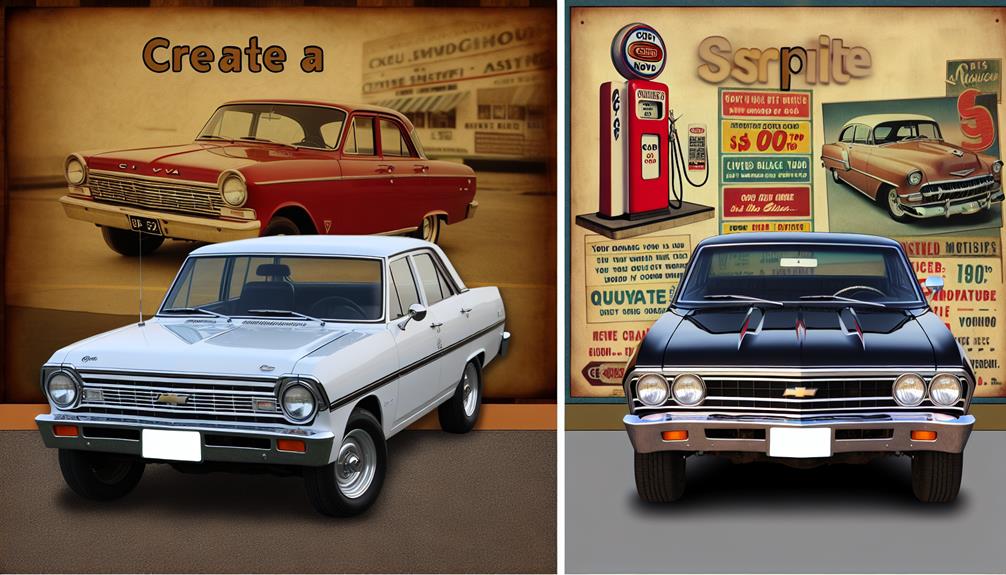
Tracing the lineage of Chevy’s muscle car royalty, you’ll discover that the Nova and Chevelle, while overshadowed by the fame of the Camaro, carved their revered places in automotive history.
Years ago, the Camaro’s first and second generations rose to stardom, yet the Chevelle, with its larger frame, garnered a strong, dedicated following. Its iconic status in the classic car community is undeniable.
The Nova, though less popular, became the more affordable option for enthusiasts, offering a gateway to muscle car ownership back in the day. Today, even as these classic Chevys become scarce, the passion for their restoration is fueled by robust aftermarket support.
Despite their rarity, you’re now more inclined to invest in rough classic models, drawn by the allure of these timeless American muscle cars.
Design and Aesthetics
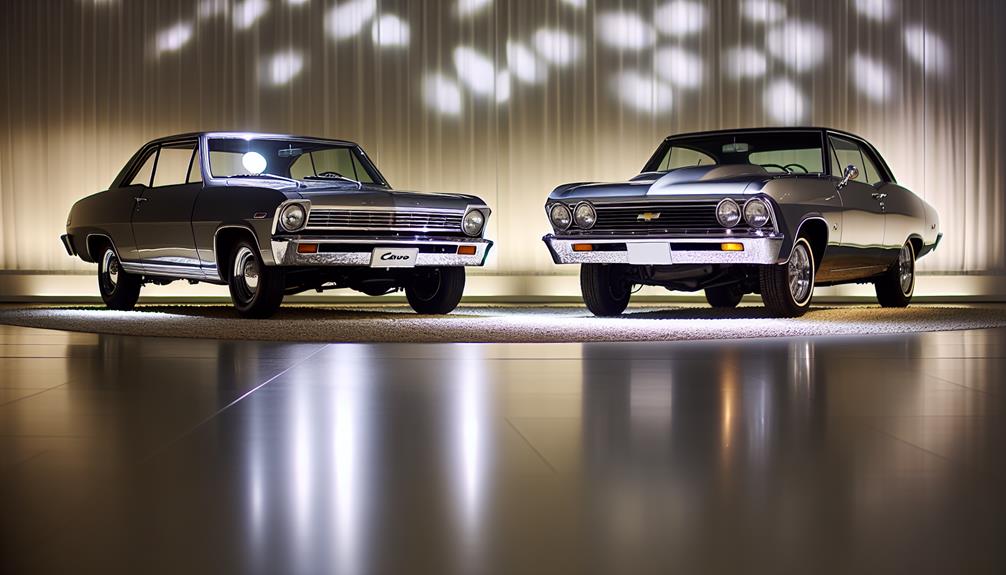
You’ve seen the Chevy Nova and Chevelle evolve stylistically over the years, each with their distinctive design cues that command attention on the road.
The Nova’s compact frame and angular lines contrast sharply with the Chevelle’s muscular contours and broad stance.
Analyzing their iconic exterior features, you’ll notice how each model carved its niche in automotive history through aesthetic innovation and appeal.
Styling Evolution Over Years
Over several decades, both the Chevy Nova and Chevelle underwent significant transformations in design and aesthetics, reflecting the dynamic shifts in consumer tastes and automotive trends. You’ll notice the Nova’s journey from a boxy, practical body style to a more streamlined, sporty silhouette. Similarly, the Chevelle’s early robust, muscular frame gave way to a sleeker, elongated body style.
As you delve deeper, you’ll see the Nova’s aesthetic advanced from utilitarian to a stylized, sporty vibe, keeping pace with car enthusiasts’ evolving desires. The Chevelle’s sharp angles softened into smoother curves, a testament to the era’s design ethos.
Both models showcased continuous refinements in grille patterns, headlight arrangements, and overall body shapes, ensuring they remained at the forefront of contemporary design and consumer appeal.
Iconic Exterior Features
Building on their aesthetic evolutions, the Chevy Nova and Chevelle each boast iconic exterior features that set them apart in the realm of classic American muscle cars.
The Nova’s squared-off shape offers a minimalist hot rod allure, with understated chrome accents accentuating its practical design.
In contrast, the Chevelle commands attention with its long hood and curvaceous lines—a quintessential representation of muscle car might. Its larger dimensions and fender bulges scream power, complemented by dual stacked headlights and a prominent grille that underscore its aggressive stance.
While the Nova’s simplicity speaks to functionality, the Chevelle’s elaborate chrome trim and muscular rear haunches articulate a narrative of performance and style, defining the era’s automotive bravado.
Engine and Performance
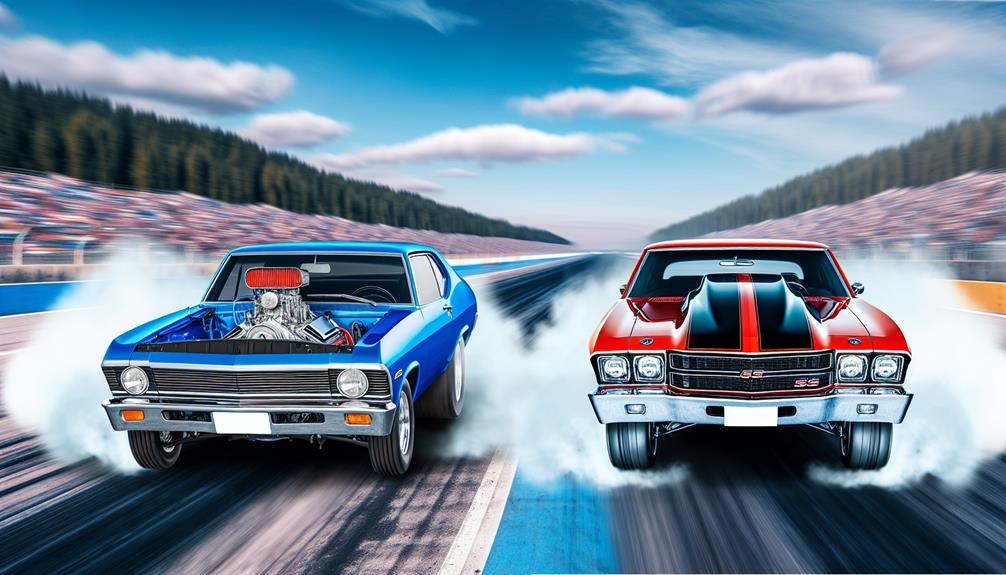
Why did the Chevy Nova and Chevelle become legends on the streets and drag strips? It’s largely due to their robust engine options and performance capabilities that enthusiasts still celebrate today.
The Nova’s potential skyrocketed with big-block engines, transforming it into a high-performance beast. Its unibody construction shaved off weight, sharpening its handling and acceleration. You’d often find it outpacing heavier rivals.
Meanwhile, the Chevelle boasted a muscular lineup, including the SS396’s 375 horsepower V8. That power, combined with a solid lifter cam and aluminum intake manifold, meant it roared with authority on the street. With the hefty L78 396 V8, the Chevelle held its own in drag races.
Both cars’ engine and performance prowess made them favorites for those craving speed and power.
Market Impact
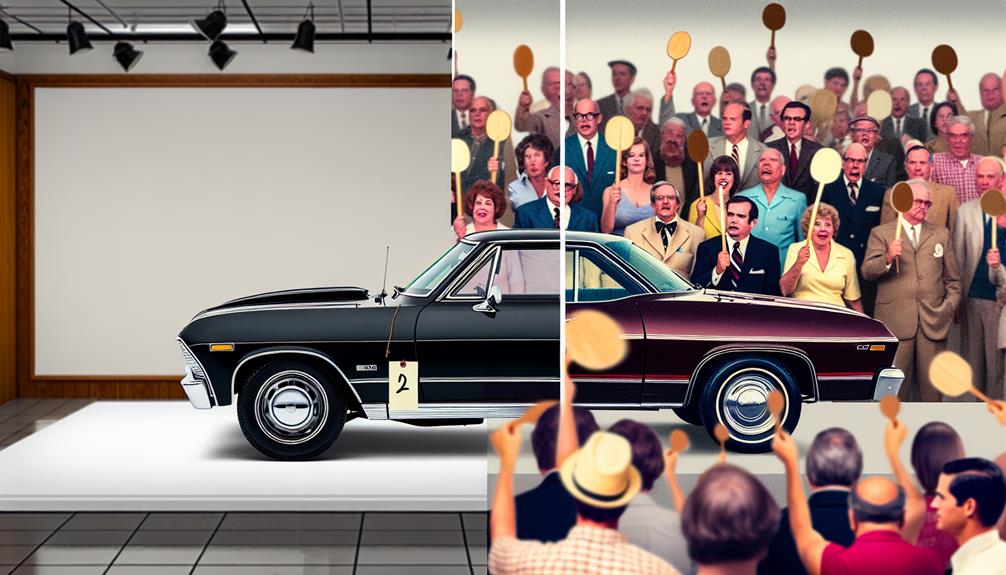
While the Nova and Chevelle’s engines thrust them into legend, their market impact solidifies their status as classic muscle car icons. You’ve witnessed how the allure of these vehicles goes beyond horsepower and torque; it’s about the legacy they’ve cemented in automotive history. Especially considering:
- Classic Chevy muscle cars are highly sought after, with Camaros and Chevelles often fetching top dollar.
- The Nova’s relative affordability makes it a good deal for muscle car enthusiasts.
- There’s strong aftermarket support, enhancing these cars’ desirability and value.
- Rarity in good condition has spiked their market value significantly.
- The undying passion of collectors ensures these models remain prized possessions.
The market dynamics underscore why the Nova and Chevelle continue to fascinate and why you, as an enthusiast, might gravitate towards one as a savvy investment.
Collectability and Value
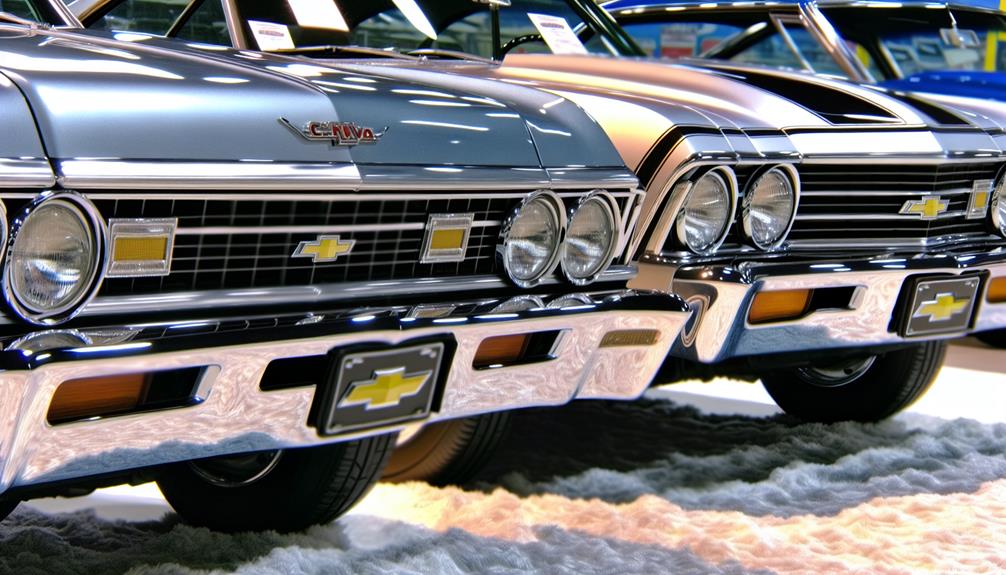
You might notice that classic Chevy cars like the Camaro often eclipse the Nova and Chevelle in terms of collectability and value.
However, the Chevelle’s SS models, with their muscular allure and limited production runs, remain hot commodities.
Meanwhile, the Nova presents a more accessible entry point into classic car collection, offering solid value due to its lower initial popularity and higher availability.
Market Trends Analysis
In the realm of classic Chevy muscle cars, the Nova and Chevelle have diverged in their collectability and value, with market trends showing a clear preference for the rarer models.
As you dive into the market trends analysis, consider the following:
- Camaro, Chevelle, and Nova’s increasing scarcity boosts their desirability.
- The Chevelle and Camaro enjoy robust aftermarket support, enhancing their appeal.
- The Nova, especially ’68-’74 models, presents a more accessible entry point due to its lower popularity.
- Rarity, such as with ’69 Camaros and box Novas, significantly inflates collectability and market value.
- The enduring legacy of these muscle cars promises sustained interest and value retention.
Understanding these trends helps you navigate the classic car market with a strategic eye toward potential investments.
Rarity and Desirability Factors
Assessing the rarity and desirability of classic Chevy muscle cars like the Camaro, Chevelle, and Nova is crucial in understanding their collectability and subsequent market value. The first- and second-gen Camaros, with their high demand, stand out, while the Chevelle’s larger size and iconic status elevate its position. However, the Nova offers an economical entry point into the realm of classic Chevys due to its lower popularity.
As you consider rarity and desirability factors, note the abundance of ’69 Camaros, the allure of big-block Chevelles, and the scarcity of box Novas. These traits significantly influence their market presence and pricing. Despite dwindling availability, aftermarket support and the unwavering enthusiasm of collectors ensure these vehicles maintain their legacy, promising sustained value and desirability.
Investment Potential Comparison
While considering the varying degrees of rarity and desirability among classic Chevys, it’s crucial to examine how these factors influence their investment potential, particularly in terms of collectability and value. Here’s an investment potential comparison to guide you:
- Camaro reigns supreme in popularity and value, with first- and second-generation models being highly sought after.
- The Chevelle, a quintessential muscle car, particularly older ’64s and ’65s, is witnessing a surge in popularity and thus, value.
- The Nova, while not as celebrated, offers a more accessible entry point for enthusiasts, presenting a solid investment opportunity.
- Rarity significantly impacts collectability; ’69 Camaros are coveted, while big-block Chevelles and scarce Box Novas fetch premium prices.
- Classic Chevy cars, despite their scarcity, maintain a dedicated following, ensuring a stable long-term investment.
Cultural Significance
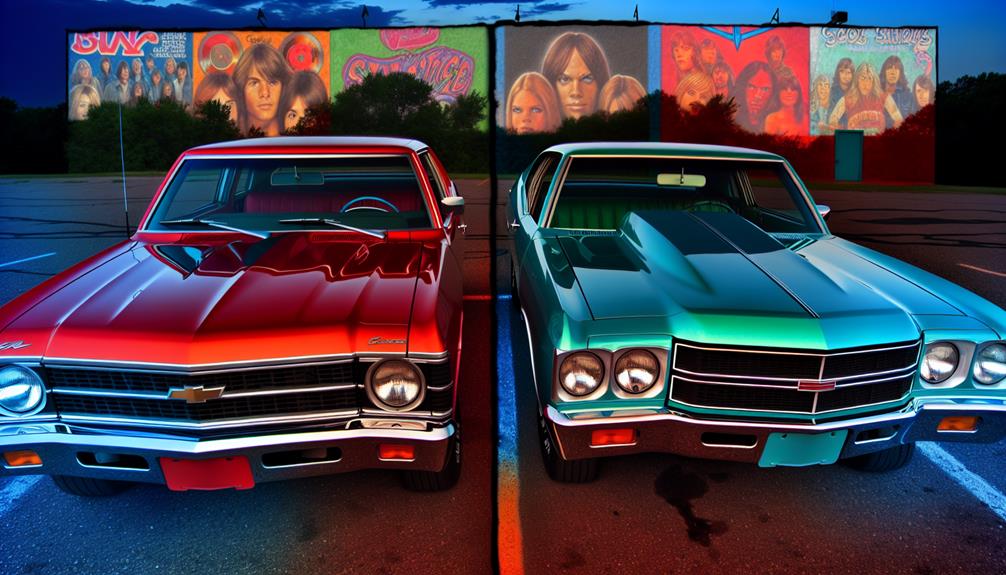
The cultural impact of the Chevy Nova and Chevelle stretches beyond mere transportation, serving as icons of American automotive history and symbols of an era defined by muscle and style.
These vehicles aren’t just old cars; they’re rolling representations of cultural significance from a time when horsepower and chrome reigned supreme. You’d recognize their distinct shapes and sounds anywhere, and they evoke a sense of nostalgia that’s palpable.
The Nova and Chevelle stand out for their embodiment of the American spirit—bold, resilient, and powerful. Analytically speaking, their enduring presence in films, television, and car shows underscores their lasting imprint on pop culture.
Descriptively, their sleek lines and roaring engines convey a story of innovation and prestige—a true testament to their status as cultural touchstones.
Conclusion
In the end, your choice between a Chevy Nova and a Chevelle hinges on personal taste and practical considerations.
The Nova’s affordability and lighter build may sway enthusiasts seeking a nimble project.
Conversely, the Chevelle’s muscular engines and iconic stature are irresistible to those valuing power and classic appeal.
Both cars offer a slice of automotive history, but it’s your vision, budget, and passion for either model that will steer your decision in the classic car arena.
